engine coolant AUDI A3 2015 User Guide
[x] Cancel search | Manufacturer: AUDI, Model Year: 2015, Model line: A3, Model: AUDI A3 2015Pages: 288, PDF Size: 71.46 MB
Page 218 of 288
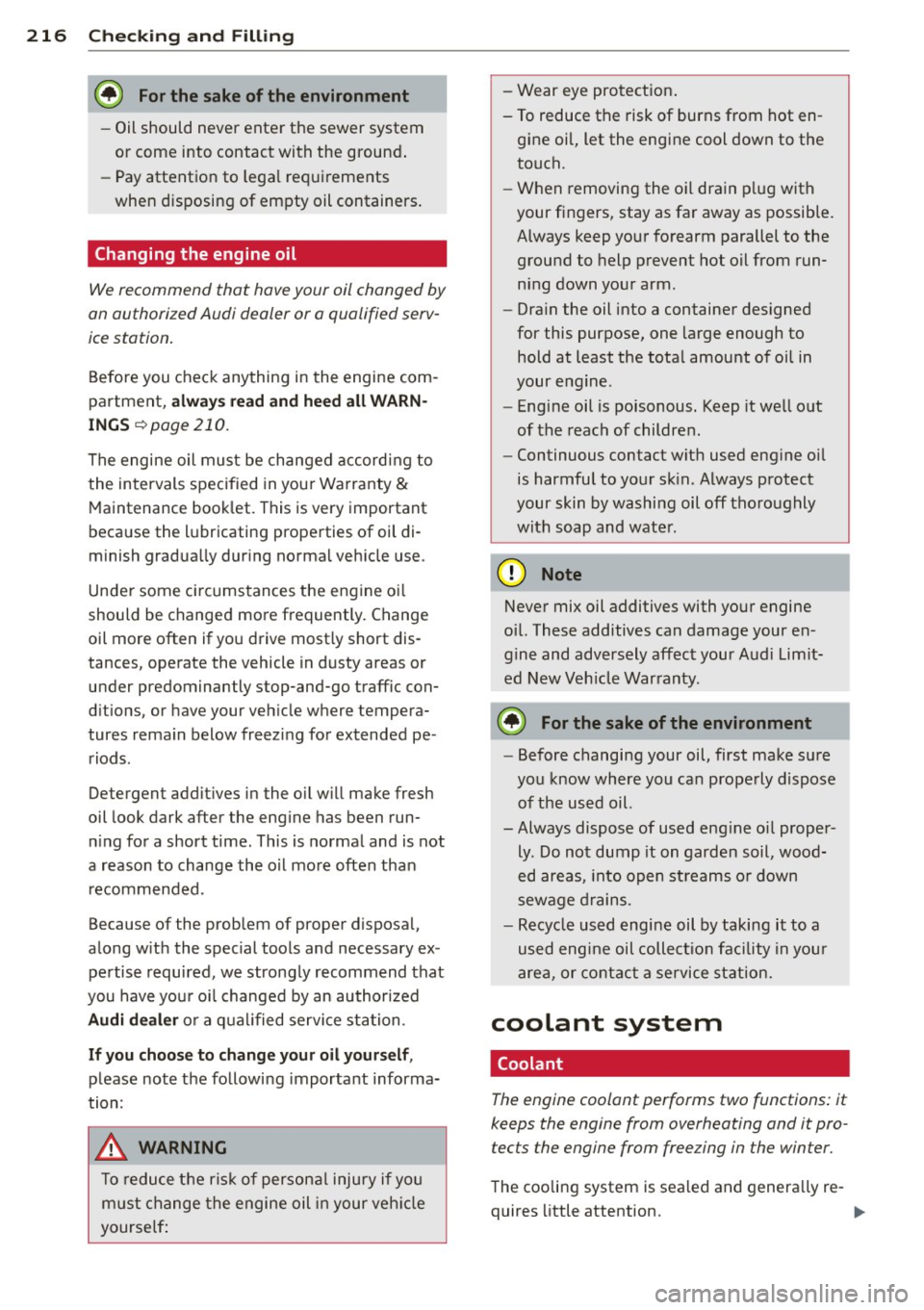
216 Check ing and F illin g
@ For the sake of the environment
-Oil should never enter the sewer system
or come into contact with the ground .
- Pay attentio n to lega l requ irements
when disposing of empty oil containers .
Changing the engine oil
We recommend that have your oil changed by
an authorized Audi dealer or a qualified serv
ice station.
Before you check anything in the engine com
partment,
a lways r ea d and heed all WARN
ING S
r=>page 210.
The engine oil must be changed according to
the intervals specified in you r Warranty
&
Maintenance book let. This is very important
because the lubricating properties of oil di
minish gradua lly during norma l veh icle use.
Under some circumstances the engine oi l
should be changed more frequently. Change
oil more often if you drive most ly short dis
tances, operate the vehicle in dusty areas or
under predominantly stop-and-go traffic con
ditions, or have your vehicle where tempera
tures remain below freezing for extended pe riods .
Detergent additives in the oil will make fresh
oil look dark after the eng ine has been run
n ing for a short time. This is normal and is not
a reason to change the oil more often than recommended.
Because of the problem of proper disposal,
along w ith the special tools and necessary ex
pertise required, we strongly recommend that
you have you r o il changed by an author ized
A udi de ale r or a q ual ified servi ce station.
If yo u choo se to c hang e your o il yo urse lf,
please note the following important informa
tion :
.8, WARNING
To reduce the ris k of persona l injury if yo u
m ust change the engine oil in your veh icle
yourself : -
Wear eye protection .
- To reduce the risk of burns from hot en -
gine oi l, let the engine cool down to the
touch.
- When removing the oil drain p lug with
your fingers, stay as far away as possible.
Always keep your forearm parallel to the
ground to help prevent hot oil from running down your arm.
- Drain the oil into a container designed
for this purpose, one large enough to
hold at least the tota l amount of oil in
your engine.
- Engine oil is poisonous. Keep it we ll out
of the reach of childre n.
- Continuous contact with used eng ine o il
is harmful to your sk in . Always protect
your skin by washing oil
off tho roughly
with soap and water.
(D Note
Never mix oil additives with your engine
oil. These additives can damage your en
gine and adversely affect your Aud i Limit
ed New Veh icle Warranty.
@ For the sake of the environment
- Before changing your oil, first make sure
yo u know where you can properly dispose
of the used oil.
- Always dispose of used eng ine oil proper
ly. Do not dump it on garden soil, wood
ed areas, into open st reams o r down
sewage drains.
- Recycle used engine oil by taking it to a
used eng ine oil collect io n fac ility in you r
are a, or contact a se rvice station.
coolant system
Coolant
The engine coolant performs two functions: it
keeps the engine from overheating and it pro tects the engine from freezing in the winter.
The cooling system is sealed and genera lly re-
quires little attention. .,..
Page 219 of 288
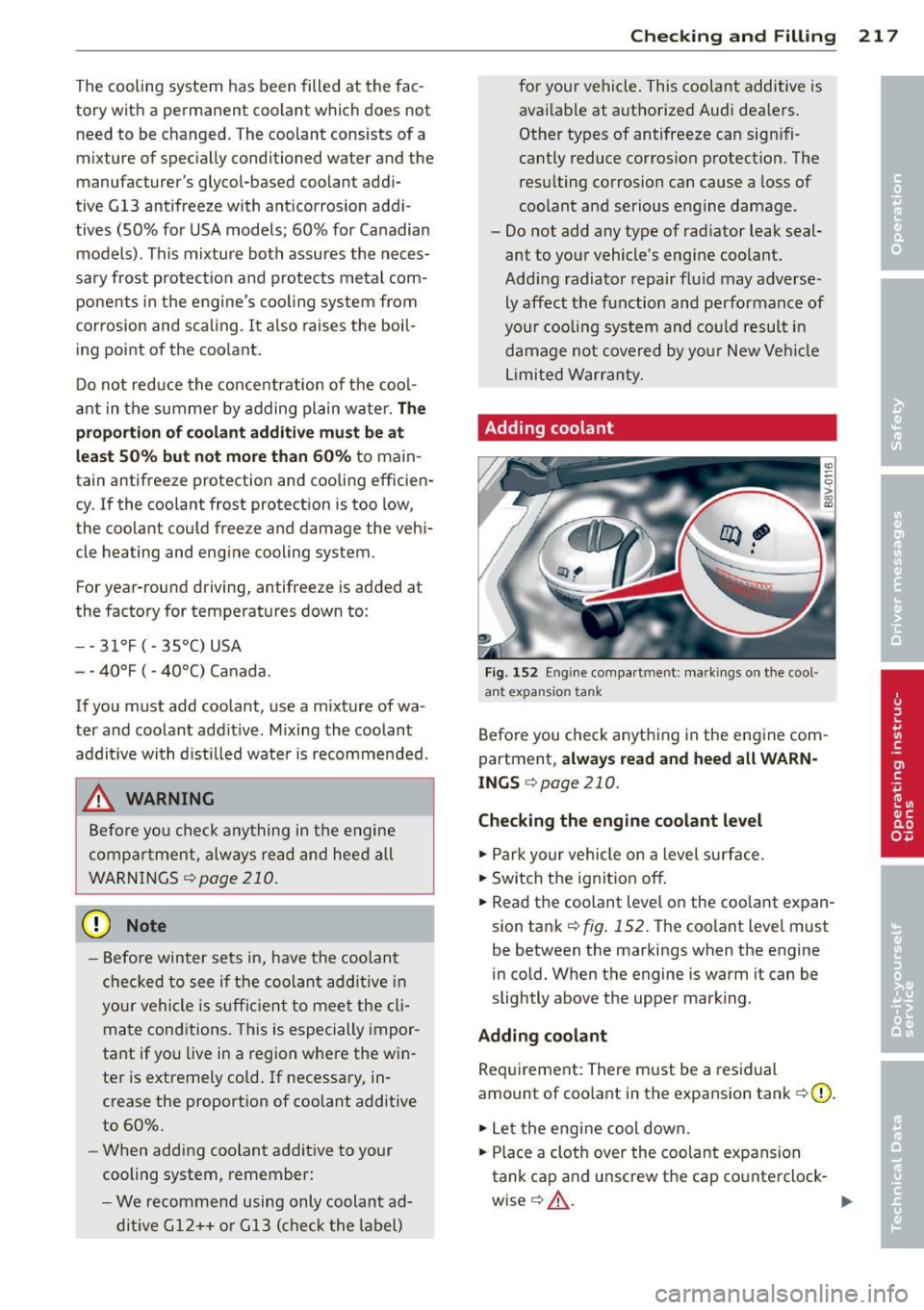
The cooling system has been filled at the fac
tory with a permanent coolant which does not need to be changed. The coolant consists of a
mixture of spec ia lly conditioned water and the
manufacturer's glycol-based coolant addi-
tive Gl3 antifreeze with anticorros ion addi
tives (50% fo r USA models; 60% for Canadian
models) . This mixture both assures th e neces
sary frost protect ion a nd p rotects me tal com
ponents in the engine 's coo ling system from
corrosion and scaling.
It al so raises the boil
ing po int o f the coo lant .
D o no t reduce the concentration of t he coo l
an t in the summer by ad ding plain w ate r.
The
proportion of coolant additive must be at
lea st 50 % but not more than 60%
to main
tain ant ifreeze protection and cooling efficien
cy. If the coolant frost protect ion is too low ,
the coolant cou ld free ze and damage the veh i
cle heating and eng ine cooling system.
F or yea r-round driv ing, antifreeze is added at
the facto ry for temperatures down to:
- -3 1 °F ( -3 5°C) USA
- -4 0°F ( -4 0°C) Canada.
If you must add coolant, use a m ixture of wa
ter and coolant addit ive. M ixing the coolant
addi tive wi th dist illed wate r is recom mend ed.
_& WARNING
Bef ore yo u check any thing in the e ngine
comp artme nt, alw ays re ad and hee d all
WARN INGS
¢page 210.
(D Note
- B efo re winter sets in, have the coolant
c hec ked to see if the c oolan t ad dit ive i n
you r vehi cle is su fficient t o mee t the cl i
mate cond itions. This is especially impor
tant if yo u live in a region whe re the win
ter is extremely cold. If necessary, in
crease the proport ion of coolant additive
to 60%.
- W hen addi ng coolant additive to your
cooling system, remember:
- We recommend using only coolant ad
ditive Gl2 ++ o r Gl3 ( check t he label)
-
Che cking and Fillin g 21 7
for you r vehi cle. This coolan t additive is
avai lab le at authorize d Audi dea le rs .
Ot her types of antifreeze ca n sig nifi
cantly reduce corros io n protection. The
res ulting corrosion can cause a loss of
coolant and serio us e ngine da mage .
- Do not add any type of rad iator leak seal
ant to you r vehicle's engine coolant .
Add ing radiator repair flu id may adverse
ly affect t he function and performanc e of
yo ur cooling sys tem and co uld resu lt i n
damage not covered by yo ur New Ve hicle
L imi ted W arranty.
Adding coolant
Fi g. 152 En gine co mpa rtment: markin gs on t he coo l
an t e xpan sio n t ank
Befo re you check a nyt hing in the eng ine com
partment ,
alway s read and heed all WARN
INGS ¢ page 210.
Checking the engine coolant level
.,. Park yo ur vehicle o n a level su rf a ce .
.,. Switch t he ignition off.
.,. Read t he coolant leve l on the coo lant expan
sion tank ¢
fig. 152. The coolant leve l must
be between the markings when the engine
in cold. When the engine is warm it can be
slightly above the upper mark ing .
Adding coolant
Req uirement : There m ust be a res idual
amount of coo lant in the expansion tank
c::> Q) .
.,. Le t the engine cool down.
.,. Place a clot h over the coo lant expans ion
tank cap a nd u nscrew the cap co unterclock-
wise
c::> _& . ..,.
Page 220 of 288
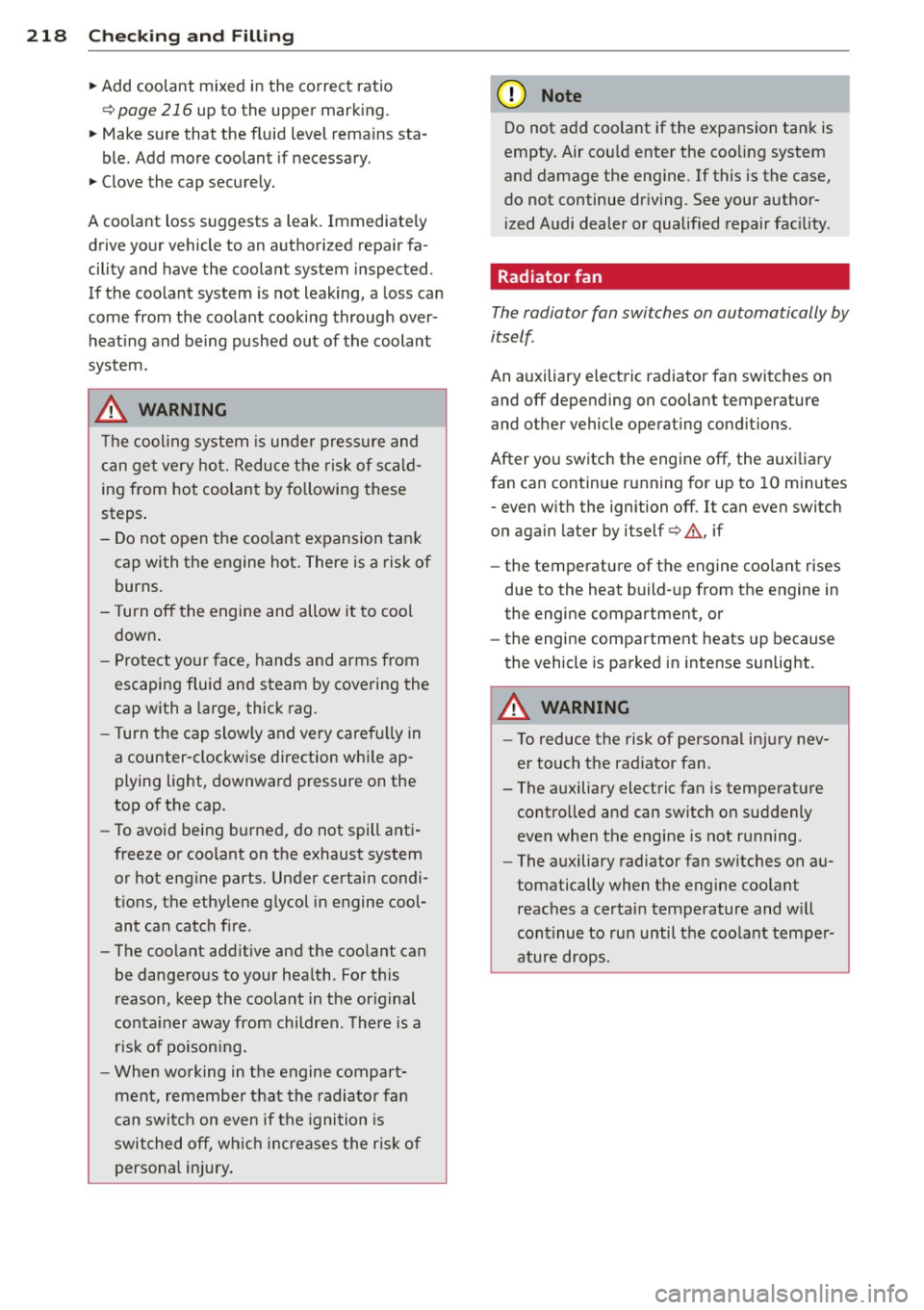
218 Check ing and F illin g
• Add coolant mixed in the correct ratio
¢page 216 up to the upper marking.
• Make sure that the fluid level rema ins sta-
ble. Add more coolant if necessary.
• Clove the cap securely.
A coo lant loss suggests a leak. Immediately
drive your vehicle to an authorized repair fa
cility and have the coolant system inspected.
If the coolant system is not leaking, a loss can
come from the coolant cooking through over
heat ing and being pushed out of the coolant
system.
.8, WARNING
The cool ing system is under pressure and
can get very hot. Reduce the risk of scald
ing from hot coolant by following these
steps .
- Do not open the coo lant expansion tank
cap with the engine hot . There is a risk of
burns.
- T urn off the engine and allow it to cool
down .
- Protect your face, hands and arms from
escaping fluid and steam by covering the
cap with a large, thick rag.
- T urn the cap slowly and ve ry carefu lly in
a counter-clockwise direction wh ile ap
plying light, downward pressure on the
top of the cap.
- To avoid being b urned, do not spill anti
freeze or coo lant on the exhaust system
or hot eng ine parts. Under certain condi
t ions, the ethylene g lycol in engine cool
ant can catch fire.
- The coo lant add itive and the coolant can
be dange rous to your hea lth. For th is
reason, keep the coolant in the or ig inal
conta iner away from children. There is a
risk of poisoning.
- Whe n work ing in the engine compart
ment, remembe r that the radiator fan
can swit ch on even if the ignition is
switched off, wh ic h increases the risk of
persona l inju ry .
(D Note
Do not add coo lant if the expansion tank is
empty. Air cou ld enter the cooling system
and damage the engine. If this is the case,
do not continue dr iving. See your author
i zed Audi dealer or qualified repair fac ility .
Radiator fan
The radiator fan switches on automatically by
itself
An a uxiliary electric radiator fan switches on
and off depending on coolant temperature
and other vehicle operat ing condit ions.
After you switch the engine off, the auxi liary
fan can continue running for up to 10 m inutes
- even w ith the ignition off.
It can even switch
on again later by itself¢.&. , if
- the temperature of the engine coo lant rises
due to the heat build- up from the engine in
the engine compartment, or
- the engine compartment heats up because
the vehicle is parked in intense sunlight.
.8, WARNING ,-
- To reduce the risk of personal injury nev-
er touch the radiator fan.
- The a uxiliary electric fan is temperat ure
controlled and can sw itch on suddenly
even when the engine is not ru nning.
- The auxiliary radiator fan sw itches on a u
tomatically when the engine coo lant
reaches a certain temperature and will
continue to run until the coolant temper
ature drops.
Page 226 of 288
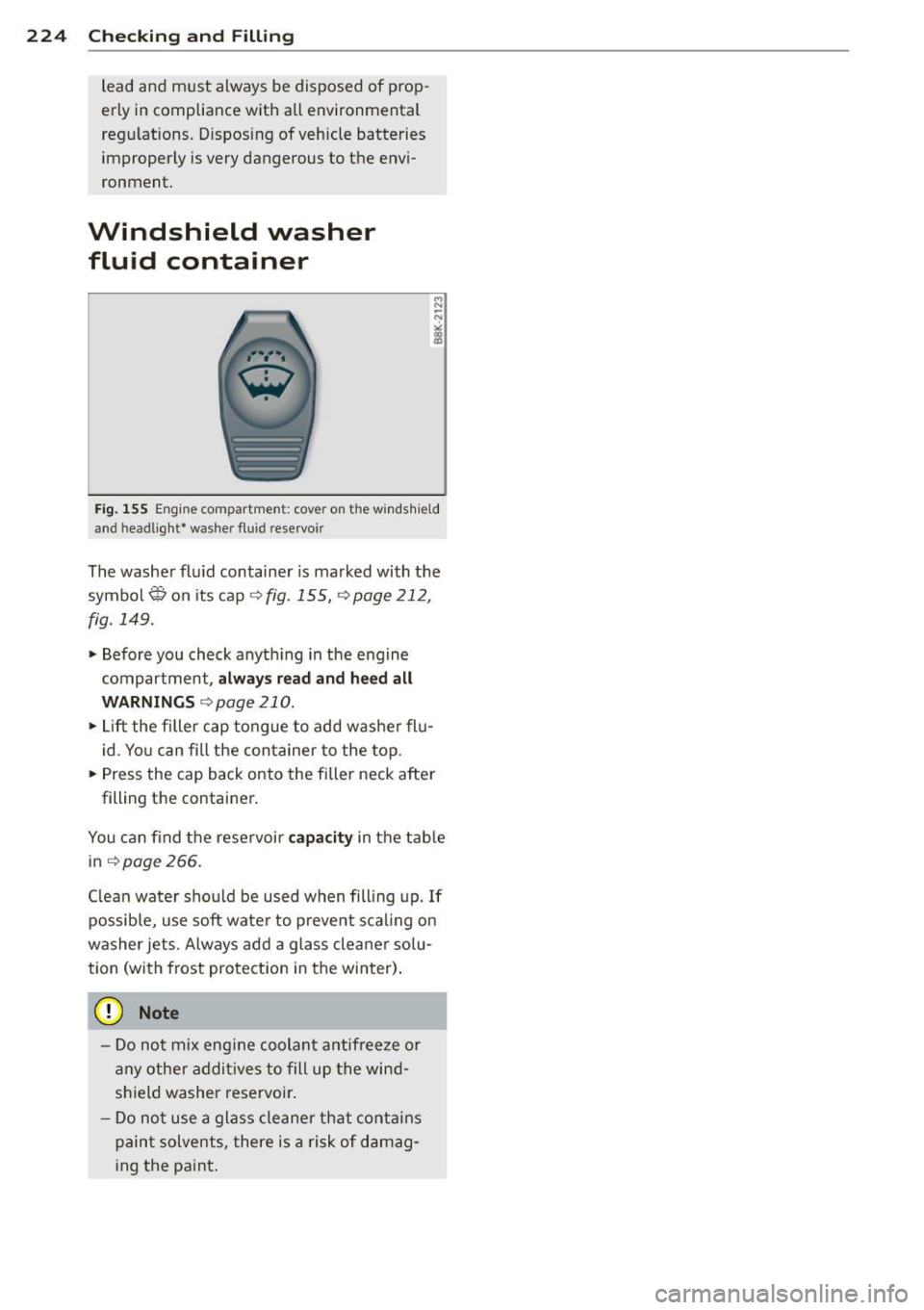
224 Checking and Filling
lead and must always be disposed of prop
erly in compliance with a ll environmental
regulations. D isposing of vehicle batteries
improperly is very dangerous to the envi
ronment.
Windshield washer
fluid container
Fig. 155 Engine co mp artmen t: cove r on the wind shield
an d h ead ligh t* washer fluid rese rvo ir
The washer flu id container is marked with the
symbol Won its cap
~fig. 155, ~page 212 ,
fig. 149 .
.. Before you check anyth ing in the engine
compartment,
always read and heed all
WARNINGS ~page 210 .
.. Lift the filler cap tongue to add washer flu
id. You can fill the container to the top .
.. Press the cap back onto the f iller neck after
filling the container.
You can find the reservoir
ca pa city in the table
in ~
page 266 .
C lean water should be used when filling up.
If
possible, use soft water to prevent scaling on
washer jets. A lways add a glass cleaner solu
tion (with frost protection in the winter) .
@ Note
- Do not mix engine coolant antifreeze or
any other additives to fill up the wind
shield washer reservoir.
- Do not use a glass cleaner that contains
paint solvents, there is a risk of damag
ing the paint.
Page 267 of 288
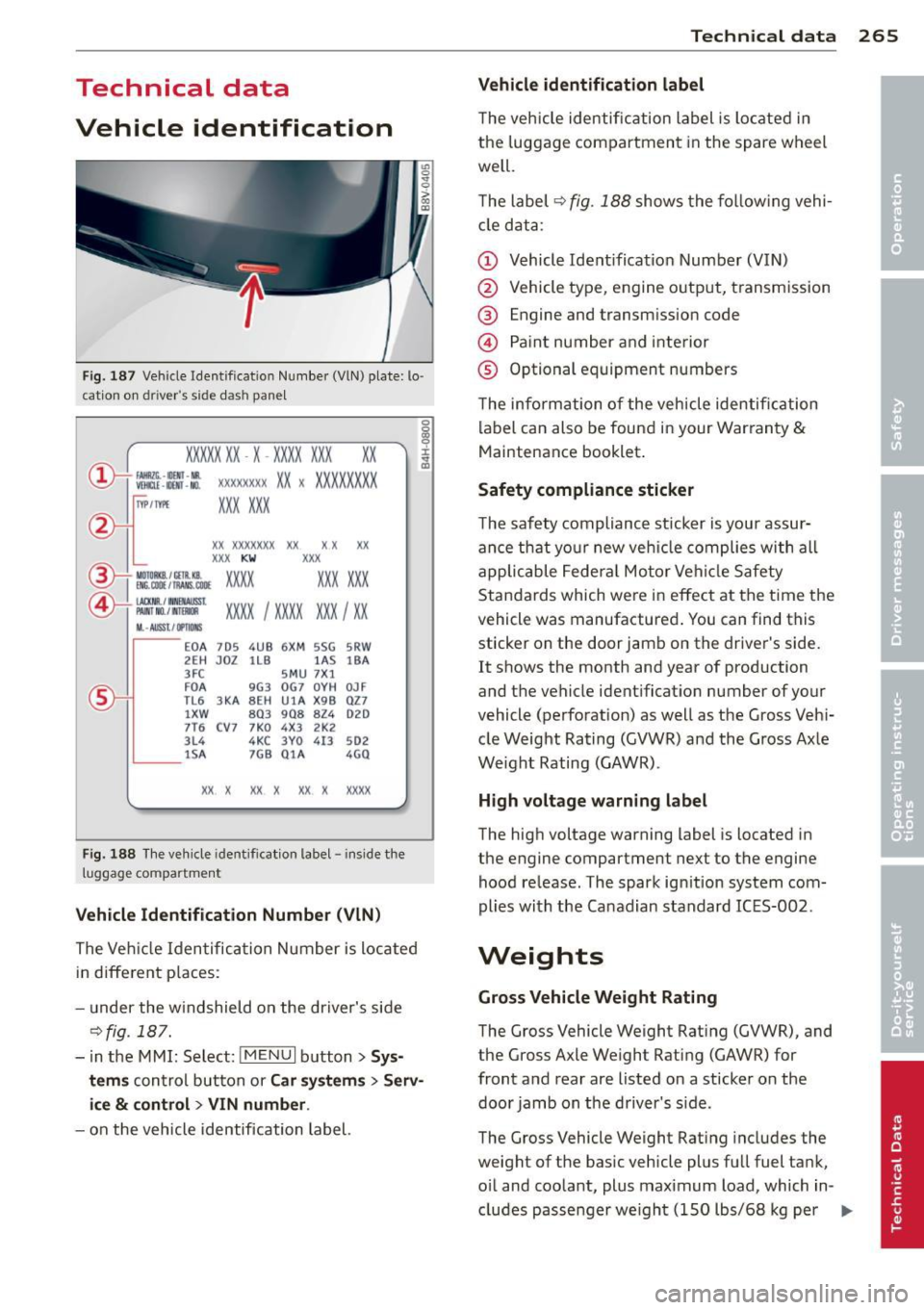
Technical data
Vehicle identification
F ig. 187 Veh icle Identificat ion Number (VlN) plate: lo·
cat ion on driver's side dash pane l
XXXXX XX · X -XXXX XXX
~ fAllftlli. -llllll · NR. ~ W!ru -llllll -NO.
xx
XXXX XXXX XX X XXXXXXXX
XXX XXX
IYP /TYPE
XX XXXX XXX XX X X XX
XXX
KW XXX
®i ~W.::·f :l~~ XXXX XXX XXX
©+ ::rw= xxxx I xxxx XXX I xx
M. · AUSSt I IJ'IIDIIS
EOA 7D5 4UB 6XM SSG SR W
2EH JOZ 1LB lAS
18A
3FC SMU 7Xl
FDA 9G3 OG7 OYH
OJF
TL6 3KA 8EH
UlA X98 027
l XW 803 908 824 D2D
7T6 CV7 7KO 4X3 2K2
3L4 4KC 3YO 413 502
1SA 7GB 01A 4GO
XX . X XX X XX X XXXX
Fig. 188 The vehicle identification label- in side the
l uggag e compartme nt
Vehicle Identification Number (VlN)
The Veh icle Identifica tion Number is located
in different p laces :
- under the w indshield on the driver's side
¢fig. 187.
- in the MMI: Select: !MENUI button> Sys
tems
control button or Car systems > Serv
i ce
& co ntrol > VIN number .
-on the vehicle identification label.
Technical data 265
Vehicle identification label
The vehicle identification label is located in
the luggage compartment in the spare wheel
well.
T he label¢
fig. 188 shows the following vehi
cle data:
(D Vehicle Identification Number (VIN)
@ Vehicle type, engine output, transmission
® Engine and transmission code
© Paint number and interior
® Optional equipment numbers
The information of the veh icle identification
label can also be found in your Warranty
&
Maintenance booklet .
Safety compliance sticker
The safety compliance sticker is your assur
ance that your new vehicle complies with all
applicable Federal Motor Vehicle Safety
Standards which were in effect at the time the
vehicle was manufactured . You can find this
sticker on the door jamb on the driver's side.
It shows the month and year of production
and the vehicle ident ification number of your
vehicle (perforation) as well as the Gross Vehi
cle Weight Rating (GVWR) and the Gross Axle
Weight Rating (GAWR) .
High voltage warning label
The high voltage warning label is located in
the engine compartment next to the engine
hood release. The spark ignition system com
plies with the Canadian standard ICES-002 .
Weights
Gross Vehicle Weight Rating
The Gross Vehicle Weight Rating (GVWR), and
the Gross Axle Weight Rating (GAWR) for
front and rear are listed on a sticker on the
door jamb on the driver's side.
The Gross Vehicle Weight Rating includes the
weight of the basic vehicle plus full fuel tank,
o il and coolant, plus maximum load, which in
cludes passenger we ight (150 lbs/68 kg per
II>--
Page 272 of 288
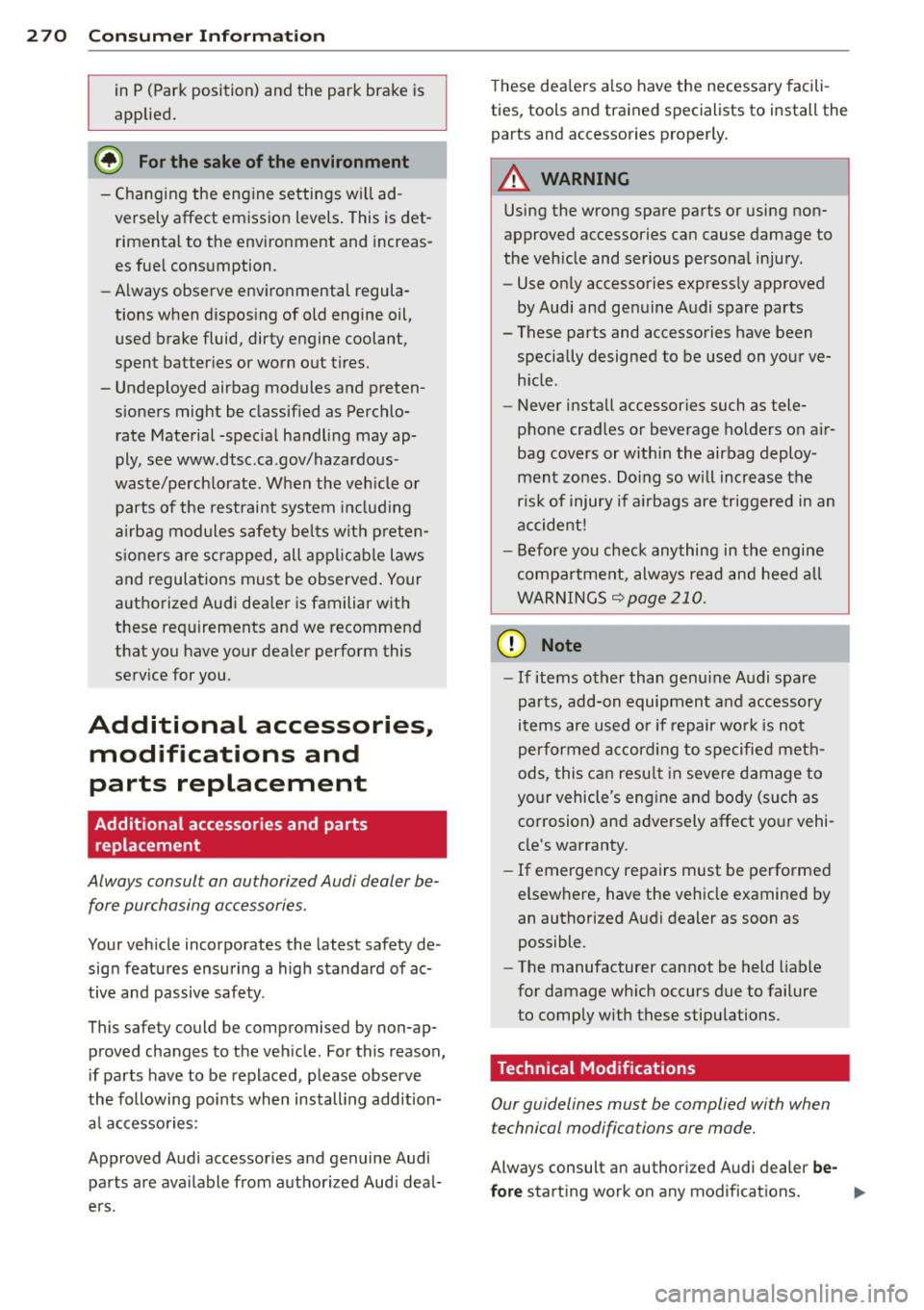
2 70 Con sum er Inf ormation
in P (Park position) and the park brake is
applied.
@) For the sake of the environment
- Changing the engine settings wi ll ad
versely affect emission levels . This is det
rimental to the environment and increas
es fue l consumption .
- Always observe env ironmental regula
tions when disposing of old engine oil,
used brake fluid, dirty engine coolant,
spent batteries or worn out tires.
- Undeployed airbag modules and preten
sioners might be classif ied as Perchlo
rate Material -spec ial handling may ap
ply, see www .dtsc .ca .gov/hazardous
waste/perch lorate . When the veh icle o r
parts of the restraint system including
airbag modules safety belts wit h preten
s ioners are scrapped, all appl icable laws
and regulations must be observed. Your
a utho rized Audi dea ler is familiar with
these requirements and we recommend
that you have your dealer perform this
serv ice for you .
Additional accessories,
modifications and
parts replacement
Additional accessories and parts
replacement
Always consult an authorized Audi dealer be
fore purchasing accessories .
Your vehicle incorporates the latest safety de
sig n features ensuring a high standard of ac
tive and passive safety .
This safety could be compromised by non-ap proved changes to the veh icle. For this reason ,
if parts have to be replaced, p lease observe
the following points when installing addition
a l accessories:
Approved Audi accessor ies and genuine Audi
parts a re ava ilable from authorized Aud i deal
e rs. These dea
lers a lso have the necessary facili
ties, tools and trained specialists to install the
parts and accessories proper ly .
A WARNING
=
Using the wrong spare parts or using non-
approved accessories can cause damage to
the veh icle and ser ious perso na l injury .
- Use on ly accessories express ly approved
by Audi and genuine Audi spare parts
- These parts and accessories have been
specia lly designed to be used on your ve
h icle.
- Never install accessor ies such as tele
phone crad les or beverage ho lders on a ir
bag covers or within the airbag deploy
ment zones . Do ing so wi ll increase the
ris k of injury if a irbags are triggered in an
accident!
- Before you check anything in the engine
compa rtment, always read and heed a ll
WARNINGS
c:::> page 210 .
(D Note
-If items other than genu ine Audi spare
parts, add-on equipment and accessory
items are used o r if repair wo rk is not
performed ac cord ing to spe cified meth
ods, this c an resu lt in seve re damage to
yo ur vehicle's eng ine and body (such as
co rrosion) and adversely affect yo ur vehi
cle's warranty.
- If emergency repairs must be performe d
elsewhere , have the vehicle examined by
an authorized Audi dealer as soon as
possible.
- The manufacturer cannot be held liable
for damage wh ich occ urs due to failure
to comply with these stipu lations.
Technical Modifications
Our guidelines must be complied with when
t echnical modifica tions are made.
Always consult an authorized Audi dealer be-
fore start ing work on any modifications. ll>-
Page 277 of 288
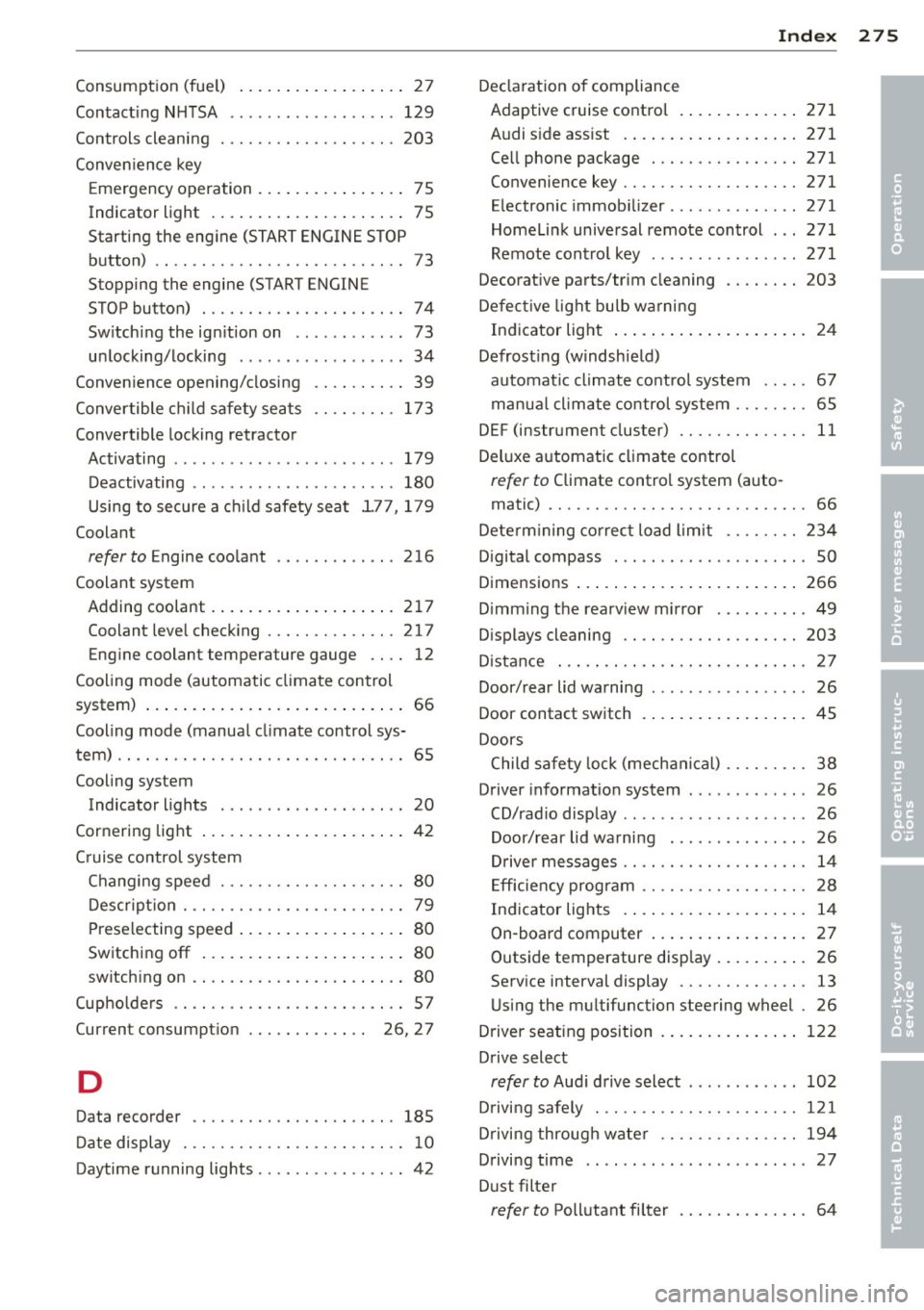
Consumption (fuel) ... ..... .. .. .. .. .. 2 7
Contact ing N HTSA .............. .... 129
Controls cleaning .......... .... .. .. . 203
Conven ience key
E mergency operation ... ... .. .. .. .. .. 75
I ndicator light . . . . . . . . . . . . . . . . . . . . . 7 5
Starting the engine (START ENGINE STOP button) .. .. ................. .. .... 73
Stopping the engine (START ENGINE
STOP bu tton) ............ .... .. .. .. 74
Sw itch ing the ign ition on ......... ... 73
un locking/locking ........... .... ... 34
Conven ience opening/closing .. .. .. .. .. 39
Conver tible c hild safety sea ts .. .. .. .. . 173
Convertible locking retractor
Activating . . . . . . . . . . . . . . . . . . . . . . . .
179
D eactivating ................ .. .... 180
Using to secure a c hild safety sea t
1.7 7, 179
Coolant
refer to Engine coo lant ..... ... ... .. 216
Coolant system
Adding coolant . ... .... ... .. .. .. .. .
2 17
Coolant leve l check ing ..... .. .. .. .. . 217
Eng ine coolant temperature gauge .. .. 12
Cooling mode (automatic clima te con trol
system) ..... .. ... .. ..... ... .. .. .... 66
Cooling mode (manua l cl imate control sys-
tem) ...... .. ................. .. .... 65
Cooling system Indicator lights . . . . . . . . . . . . . . . . . . . . 20
Cornering light .... ..... ... .. .. .. .. .. 42
C ruise control system
C hanging speed . . . . . . . . . . . . . . . . . . . . 80
D escr ipt ion . ............. .. .. .. .. ..
79
P rese lecting speed . . . . . . . . . . . . . . . . . . 80
Sw itching off .. .. ..... ... .. .. .. .. .. 80
switch ing on . ... .. .... ... .. .. .... .. 80
(upho lde rs . . . . . . . . . . . . . . . . . . . . . . . . . 5 7
Current consumpt io n . . . . . . . . . . . . .
26, 27
D
Data recorder . . . . . . . . . . . . . . . . . . . . . . 185
D ate display . ............. .... .. .... 10
Daytime running lights .......... ... ... 42
Inde x 275
Declarat ion of compliance
Adaptive cruise contro l .. .... ... .. ..
2 71
A udi s ide ass ist . ... . .. ... .... ... .. 2 7 1
Ce ll phone package ................ 271
Convenience key .. .... ............. 271
Electronic immob ilizer ............. . 271
Homelink universal remote con trol ... 271
Remote cont ro l key ............... . 271
Decorative parts/tr im cleaning .... .. .. 203
De fec tive light bu lb w arning
Ind icator light ..... . .. .. ..... ... .. . 2 4
Defrost ing (w indsh ie ld)
automat ic cl imate control system .. .. .
6 7
man ua l cl imate co ntrol system ... .. .. . 65
DEF (instrument clus ter) ......... .. .. .
11
Del uxe a utomatic climate control
refer to Climate contro l system (auto -
matic) .... .. .. .. ................. .
66
Determining co rrec t load l imit .... .. .. 234
D igital compass . . . . . . . . . . . . . . . . . . . . . 50
Dimensions ....... .. . .. .. ..... ... ..
266
D imming the rearv iew mi rror ..... .. .. . 49
D isplays cleaning .. ................. 203
D istance ... .. .. .. .. . .. ... .... ... .. .
27
Door/ rear lid warning . .. .. ...... .... .. 26
Door contact switch . . . . . . . . . . . . . . . . . . 45
Doors Child sa fety lo ck (mech ani cal) .... .. .. . 38
Driver informat io n system ........... ..
26
CD/rad io disp lay .. .. . .. .... .... .. .. . 26
Door/rear lid wa rni ng . ...... ... .... . 26
Drive r messages . . . . . . . . . . . . . . . . . . . . 14
E ff iciency program . . . . . . . . . . . . . . . . . . 28
Ind icator lights .... . .. .. ..... ... .. . 14
On-board computer .. .. ..... ... .. .. .
27
Outside temperature disp lay .. ... .. .. . 26
Serv ice interval display . . . . . . . . . . . . . . 13
U sing the mu ltifunction steering wheel .
26
Driver seating position ... ..... ... .. .. 122
D rive select
refer to Aud i d riv e select ........... . 102
D riving safely . . . . . . . . . . . . . . . . . . . . . .
121
Drivi ng throug h wate r ........... .. .. 194
Driving time . . . . . . . . . . . . . . . . . . . . . . . .
27
D ust filter
refer to Poll utant fi lter ......... .... . 64
•
•
•
Page 278 of 288
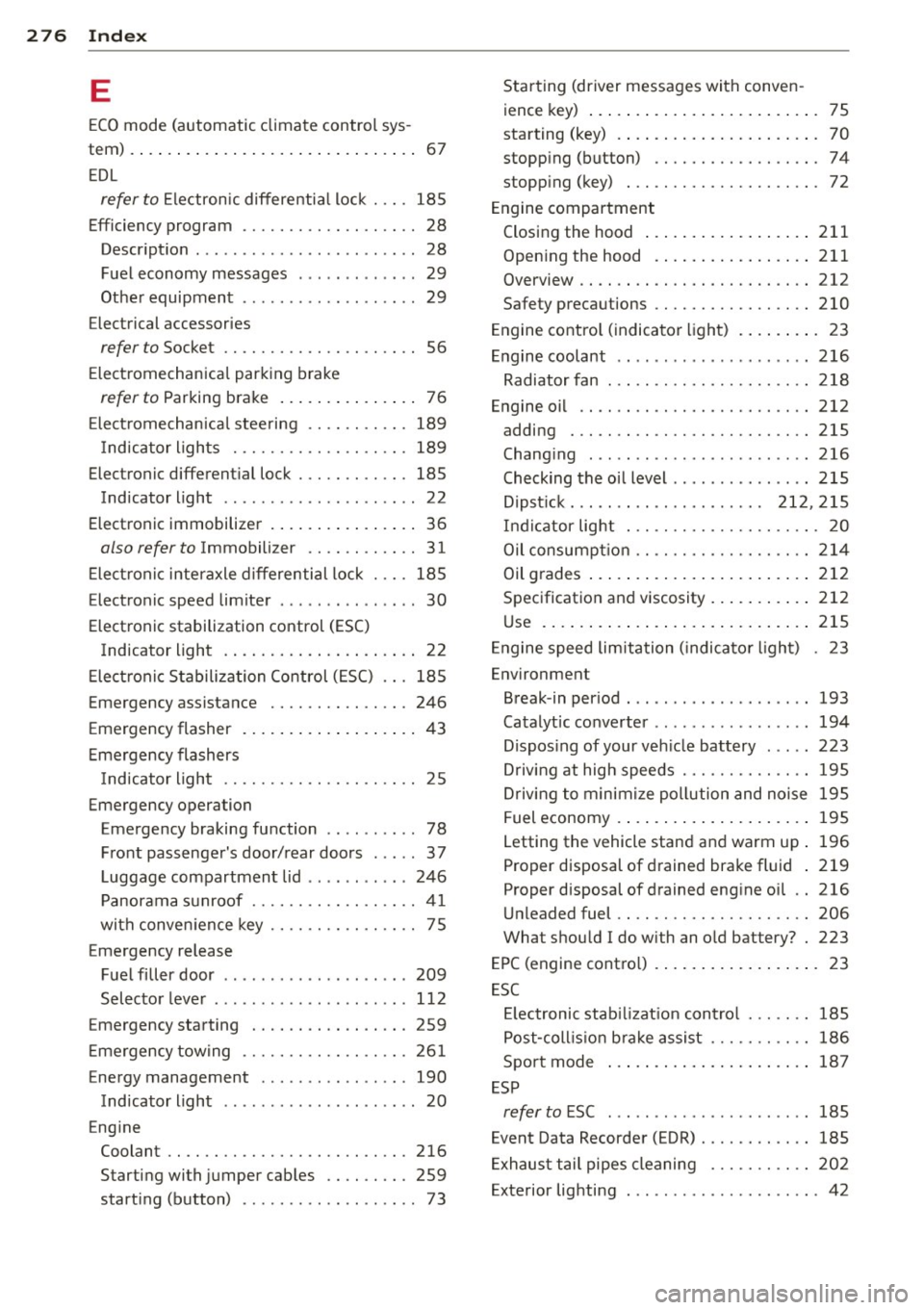
276 Index
E
ECO mode (automatic climate control sys -
tem) . ..... .. ................ ..... .. 67
EDL
refer to Electronic differentia l lock . .. . 185
Efficiency program . . . . . . . . . . . . . . . . . . . 28
Description . ...... .......... ... .. .. 28
Fuel economy messages . . . . . . . . . . . . . 29
Other equipment . . . . . . . . . . . . . . . . . . . 29
Electrical accessories
refer to Socket ............. .. .... .. 56
Electromechanical parking brake
refer to Parking brake ............... 76
Electromechanical steering .. .. .. .. .. . 189
I ndicator lights .......... .. .. .... . 189
Electronic differential lock ... .... .... . 185
Indicator light . . . . . . . . . . . . . . . . . . . . . 22
Electronic immobilizer ....... ... .... .. 36
also refer to Immobilizer . . . . . . . . . . . . 31
E lect ronic interaxle differential lock .... 185
Electronic speed limiter ..... .. .. .. .. . . 30
Electronic stabilization control (ESC)
Indicator light . . . . . . . . . . . . . . . . . . . . . 22
Electronic Stabilization Control (ESC) ... 185
Emergency assistance .......... .... . 246
Emergency flasher .......... ... .... .. 43
Emergency flashers
I ndicator light . . . . . . . . . . . . . . . . . . . . . 25
Emergency operation Emergency braking function .. .. .. .. . . 78
Front passenger's door/rear doors . . . . . 3 7
L uggage compartment lid ........ .. . 246
Panorama sunroof ........ .. .. ...... 41
with conven ience key .... .. .. .. .. .. . . 75
Emergency release Fuel filler door .............. ... ... 209
Selector lever . . . . . . . . . . . . . . . . . . . . . 112
Emergency starting ........ .. .. .. .. . 259
Emergency towing ......... .. .. .. .. . 261
Energy management . . . . . . . . . . . . . . . . 190
Indicator light . . . . . . . . . . . . . . . . . . . . . 20
Engine Coolant .. .. ..................... . 216
Starting with jumper cables .... .... . 259
starting (button) . .. ...... .. .. .. .. . . 73 Starting (driver messages with conven-
ience key) ..... .. ................ .. 75
starting (key) . ... ................ .. 70
stopping (button) ............. ..... 74
stopping (key) ................ ..... 72
Engine compartment
Closing the hood . . . . . . . . . . . . . . . . . . 211
Opening the hood ................ . 211
Overview .. .... .. ... .......... .... 212
Safety precautions ............... .. 210
Engine control (indicator light) . . . . . . . . . 23
Engine coolant .. .. .......... ... .. .. 216
Radiator fan ... .. ... .......... .... 218
Engine oil .. ................... .... 212
adding . .. .. .. .. ... .......... .... 215
Changing . ...... ... ......... ... .. 216
Checking the oil level ... ..... ... .. .. 215
Dipstick... .. .. .. .... .... .... 212, 215
Indicator light .................... . 20
Oil consumpt ion .. ............. .. .. 214
Oil grades ..... .. ............. .... 212
Specification and viscosity ........ ... 212
Use ..... ..... .. .. .............. . 215
Engine speed limitation ( indicator light) . 23
Environment Break -in per iod . .. ... ....... ... .. .. 193
Catalytic converter ....... ...... .. .. 194
Disposing of your vehicle battery ..... 223
Driving at high speeds .......... .... 195
Driving to minimize pollution and noise 195
Fuel economy .... ................ . 195
Letting the vehicle stand and warm up . 196
Proper disposal of drained brake fluid . 219
Proper disposal of drained engine oil .. 216
Unleaded fuel .... ... .......... .... 206
What should I do with an old battery? . 223
EPC (engine control) ................ .. 23
ESC Electronic stabilization control ... .. .. 185
Post-coll is ion brake assist ..... .. .. .. 186
Sport mode ... .. ................ . 187
ESP
refer to ESC ... .. ..... ..... ... .. .. 185
Event Data Recorder (EDR) ............ 185
Exhaust tail pipes cleaning ........... 202
Exterior lighting ... ..... ..... ... .. .. . 42
Page 284 of 288

282 Index
Selector leve r (automatic transmission)
Emergency operation . ... .. .. ... ... . 1 12
Position ... ... ... .... ... .. .. .... . 105
Service and disposal Safety belt p retens ioner ... .. .. .... . 138
Service in terval d isp lay
with d rive r info rmat ion system .. .. .... 13
Sett ing clock ... ............. .. .... .. 10
Sett ing da te ............ .. .. .. .. .. .. 10
Sett ing t he temperature
a utomatic cl ima te control system ... . . 67
Sett ing t ime ... .. ...... ... .. .. .... .. 10
SE TUP (basi c sett ing) ....... .. .. .... .. 10
Shift i ndicator .. ........... .. .. .... .. 12
Shift paddles (automatic transmiss ion) . 110
Short-te rm me mory ......... ... .. .. .. 27
Side airbags Descr ipt ion ................ .. .... . 160
H ow they work ............ ... .. .. . 161
Side assist . . . . . . . . . . . . . . . . . . . . . . . . . . 98
Ad justing the br ightness ... .. .. .... . 100
C leaning the sensors ...... .. .. .. .. . 202
Sensor range .............. .. .... .. 99
switch ing on and off ....... ..... .. . 100
Side curta in a irbags ..... ... .. .. .... . 163
Descript ion .. .. . ...... ... .. .. .... . 163
How they wo rk ........... .... .... . 164
Safety instructions ........ .. .. .. .. . 164
Sliding/ tilting sun roof
refer to Panorama sunroof ... .... .. . . 40
Snow chai ns . ... .. ..... ... .. .. .. .. . 241
All whee l dr ive ........... .. .. .... . 190
Socket .. .. .. ............... .. .... .. 56
Sources of in formation about chi ld re -
straints and their use . . . . . . . . . . . . . . . . 184
S peed li mite r ........... .. .. .. .. .. .. 30
Speedometer . . . . . . . . . . . . . . . . . . . 10, 26
Spee d rating let ter code ... .. .. .... .. . 23 7
Speed war ning system ... ... .. .. .. .. . . 79
Sport mode .... ........... .. .. .... . 187
S tar bu tto n .. ............. .. .. .. .. .. 27
STAR T ENGINE STOP button (convenience
key) ...... .. ................ ... ... . 73
S TART ENGINE STOP (convenience key) ... 74
S tarti ng
H ill hold . ............... .. .. .... .. 78 Starting from a stop
Hill start assist ... .. ... ..... ... .. .. . 77
S tarting (eng ine)
A ut oma tic start (bu tton) ........ .. .. . 73
A utomati c start (key) . . . . . . . . . . . . . . . . 70
Malfunction (b utton) . . . . . . . . . . . . . . . . 73
Malfunction (key) .... .. ..... .... . .. . 71
with button . . . . . . . . . . . . . . . . . . . . . . . 73
with key .. .... .. .. ........... .... . 70
Stee ring
El ec tromec hanical s teer ing . . . . . . . 189, 0
I nd icator light ... .. .... .... ... .. .. . 21
Locking steering (ignition key) .... . .. . 72
Locking the steering (button) .... .. .. . 74
locking (mecha nica l ignition key) . .... . 70
also refer to Electromechanical steer-
ing ........ ... .. .. ... ........... . 189
Stee ring wheel
adjusting . .... .. ............. .... . 70
Buttons . .. .. .. .. ............. .. .. . 27
Mult ifunct ion steer ing whee l .. .. .... . 26
S hift paddles (automatic transmission) 110
Steps for determining cor rect load limit . 234
Stoppi ng (engi ne)
wi th bu tton . . . . . . . . . . . . . . . . . . . . . . . 7 4
wi th key . ..... .. .. .... .... ... .. .. . 72
Storage compa rtments . . . . . . . . . . . 57, 58
S tronic transmission
refer to Aut omatic transmission .. .. .. 105
Su bwoofer .. .... .. ............. .... 2 48
Su n visors .. ... ... .. .............. .. 46
Switching dayt ime ru nning lights on and
off .... .... .... .. ............. .... . 44
S wi tching the igni tion on and off (w ith
key) ... .. .. .... .. .. ... ..... ... .. .. . 70
Symbols
refer to I ndicator ligh ts . . . . . . . . . . . . . . 14
T
Tachometer . . . . . . . . . . . . . . . . . . . . . 10, 11
T ail lights cleaning .... .. ..... ... .. .. 202
T echnical data ... .. ............. .... 265
Technical modificati ons .......... .... 270
T emperature display
Coolant ... .... .. .. ... ..... ... .. .. . 10
Outside air tempe ratu re ..... .... . .. . 11